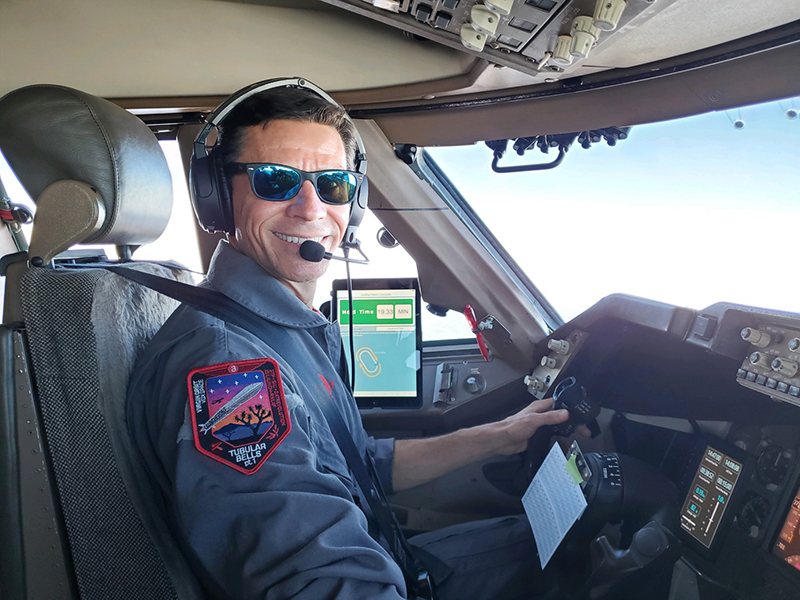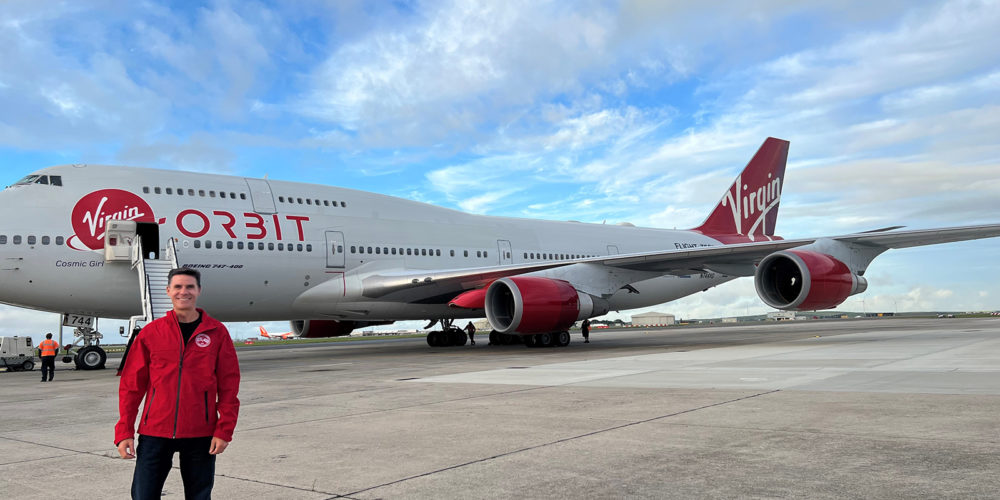Champagne in your hair? That’s an occupational hazard for a test pilot who knows his way around a rocket launcher.
Rigorously trained for every eventuality, Eric Bippert (’99, ’06) knew the drill after three successful launches and two years as chief pilot for Virgin Orbit. His fourth flight held this summer, Straight Up, was worthy of extra celebration as Virgin Orbit’s first night launch. Execution went exactly as expected, and Bippert says the mission was a confidence booster that proved the high capability of the platform.
In July, the Straight Up launch sent seven satellites into low-Earth orbit for the U.S. Space Force. Before the launch, the mobile LauncherOne rocket was mated to a 747 affectionately named Cosmic Girl and positioned on a concrete pad at the end of the runway at the Mojave Air and Space Port in California. Satellites now in orbit will enable experiments on spacecraft technology and satellite applications as well as Earth atmospheric science research. With Straight Up, the company launched 33 satellites in total.
Soon he is helping Virgin Orbit score another first in Cornwall — the first of many satellite launches planned from United Kingdom soil. This history-making European launch is a collaborative effort with the UK Space Agency, Royal Air Force, Civil Aviation Authority and Space Port Cornwall to place nine satellites into orbit.
The U.K. already has a thriving space industry focused on satellite manufacturing, spacecraft design and data applications. The prospects for future U.K.-based launches are encouraging thanks to a long coastline and multiple launch sites in England, Scotland and Wales. The far North location is perfect for sending satellites into polar and Sun-synchronous orbits for telecommunications.
Bippert has been a test pilot for 13 years, with more than 1,000 flight test hours and 5,000-plus total flight hours in 56 different aircraft. He loves test flights because of the excitement and challenge, and also because he is contributing to the safety and reliability of components and aircraft and improving upon the foundation of aerospace capabilities.

Not every pilot has the right combination of skills and temperament for the job. “You need a strong technical foundation and a safety mindset,” he says. “When you test something or do something for the first time in an aircraft, there’s a safety process to follow to mitigate risks. Your technical foundation comes into play to ensure you understand the system, the data you are after and the safest possible maneuvers to get it.”
His technical foundation is built upon two Embry-Riddle degrees, a bachelor’s degree in Aviation Computer Science and a master’s degree in Aerospace Safety Systems, and a career in the U.S. Air Force, including attending U.S. Air Force Test Pilot School, followed by commercial experience with United Airlines, where he now works again after a leave of absence due to Covid-19. His training gave him the opportunity to fly “everything from the Goodyear Blimp to a MiG-15 to a U-2.”
He grew up in San Diego, near Miramar Naval Air Station, home to TOPGUN. “Seeing F-14s and E-2C Hawkeyes overhead captivated me. Going to the Miramar Air Show sparked my interest in aviation. When I was 14, I had my first private plane ride. It was over — it only took one flight.”
A brochure in the mail introduced him to Embry-Riddle. When he toured the Prescott Campus, he noticed everyone looking up at airplanes and knew he was in the right place. He received an Air Force ROTC scholarship and earned his undergraduate degree in Computer Science, returning years later to Worldwide for his master’s.
“After my freshman year, I went back to San Diego and got my private pilot’s license,” he says. “I have fond memories of flying with friends at Embry-Riddle. We would rent airplanes, fly to Sedona and get the $100 hamburger over there. Embry-Riddle undoubtedly gave me a strong foundation in education and aerospace that propelled my future.”
Straight Up and Fly Right
A key distinction for a rocket air-launch flight like Straight Up is the dedicated flight path that minimizes risk if the rocket is jettisoned. “We operate the airplane normally to the launch airspace, talking to air traffic control on one radio and our mission control center via satellite radio. The difference though, is that we have a dedicated flight path when we take off out of Mojave and go out over the ocean.” That requirement will hold true during future missions at different locations.
“When I was 14, I had my first private plane ride. It was over — it only took one flight.”
— Eric Bippert (’99, ’06), Virgin Orbit test pilot
However, once in the drop area, the launch release maneuver is not normal procedure for a 747. “After accelerating to .85 Mach, we perform a 2-g pull-up from 30,000 feet up to 33 degrees nose high and wait for all of the drop parameters to fall into place before pressing a button to release the rocket. Once the rocket is released, we bank up to 60 degrees and perform a nose-high recovery maneuver before the aircraft stalls.”
Bippert completed extensive simulation and practice runs to prepare for the Straight Up launch in July. The night flight was a rehearsal for the flight scheduled after Christmas. “We will be flying in a new country at night, so this was a way to buy down risk.”
The main consideration for flying at night was human factors. Simulations extended to evaluating lighting on the ground, looking at configurations within the upper deck where the launch engineers sit behind the cockpit and lighting in the cockpit itself. Then they checked lighting during taxi evaluations followed by landings at Mojave.
After that, Bippert and the team flew practice sorties all the way through a practice launch from Mojave. “We check details,” he says. “Can we see switches? Can we operate switches? Does lighting impact how we’d operate? We are simultaneously running through our standard procedures and checklists to make sure we can do everything we need to.”
There are no practice rockets, but to simulate the rocket attached to the wing of Cosmic Girl, the team adds extra fuel to the left side of the aircraft to recreate the lateral weight imbalance experienced with the rocket. The Boeing 747-400 aircraft is highly modified, according to Bippert. “The lower deck has no seats or sidewalls. Overall, we cut 60,000 pounds of weight. Avionics and hardware at the launch engineers’ stations are used to monitor and control the rocket, and a panel in the cockpit allows us to arm and drop the rocket.”

Carrying the rocket also demands modifications. “Gas pallets onboard supply gaseous helium and nitrogen to the rocket during captive carry. On the left wing, structural modifications support the heavier load of the pylon and the rocket on that wing, as well as bleed air lines and extra plumbing to support the rocket while we’re flying with it.”
Bippert doesn’t have any personal pre-flight rituals because by the time the launch is scheduled, he can rely on practice and proficiency. The realism of the 747 simulator at NASA Ames Research Center allowed him to practice the entire launch mission including the launch release maneuver — the most challenging aspect of the mission — with confidence.
“In conjunction with the mission control center, we fly missions over and over and practice emergency procedures to be ready for any contingency with the plane or the rocket. We coordinate with the launch engineers and run through scenarios until it becomes second nature. The launch release maneuver becomes muscle memory. When you do it for real, it doesn’t feel new.”
With this fifth successful flight, Bippert says there isn’t anything else on his aviation bucket list. “Having flown just about every major type of aircraft and being a part of some really unique flight experiences, I feel fulfilled and extremely fortunate. We’ll see what the future holds, but there isn’t anything right now that I’m dying to do that I wish I could.”
